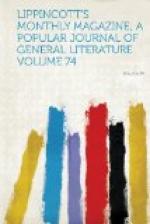“My wife,” said Mr. Rayne with laughter in his eyes.
Mrs. Rayne talked much like other people, and her beauty ceased to dazzle me after a few minutes; not that it grew less on near view, but, being a woman, I could not fall in love with her in the nature of things.
When the music stopped we drove to Mr. Rayne’s house, his wife keeping easily beside us. When she was occupied with the others Mr. Rayne whispered, “Her praises were so sweet in my ears that I would not own myself Sir Lancelot at once.”
“If you are Sir Lancelot,” I said, “where is King Arthur?”
“Forty fathoms deep, I hope,” said Mr. Rayne with a sudden change in his voice and a darkening face. I had raised a ghost for him without knowing it, and he spoke no more till we reached the house.
It was a long, low, spreading structure with a thatched roof, and a verandah round it. A wilderness of tropical plants hemmed it in. But all appearance of simplicity vanished on our entrance. In the matted hall stood a tree to receive the light coverings we had worn; not a “hat tree,” as we say at home by poetic license, but the counterfeit presentment of a real tree, carved in branches and delicate foliage out of black wood. The drawing-room was eight-sided, and would have held, with some margin, the gambrel-roofed house, chimneys and all, in which I had spent my life. Two sides were open into other rooms, with Corinthian pillars reaching to the roof. Carved screens a little higher than our heads filled the space between the pillars, and separated the drawing-room from Mrs. Rayne’s boudoir on the side and the dining-room on the other.
The furniture of these rooms was like so many verses of a poem. Every chair and table had been designed by Mrs. Rayne, and then realized in black wood by the patient hands of natives.
Another side opened by three glass doors on a verandah, and only a few rods below the house the sea dashed against a beach.
After dinner I sat on the verandah drinking coffee and the sea-breeze by turns. The gentlemen walked up and down smoking the pipe of peace, while Mrs. Rayne sat within, talking with Rhoda in the candlelight. Opposite me, as I looked in at the open door, hung two Madonnas, the Sistine and the Virgin of the Immaculate Conception. In front of each stood a tall flower-stand carved to imitate the leaves and blossoms of the calla lily. These black flowers held great bunches of the Annunciation lily, sacred to the Virgin through all the ages. Mrs. Rayne had taken off the close-buttoned jacket, and her dress was now open at the throat, with some rich old lace clinging about it and fastened with a pearl daisy.
“Have you forgiven me the minute’s deception I put upon you?” said Mr. Rayne, pausing beside me. “If I had not read admiration in your face, I would have told you the truth at once.”
“How could one help admiring her?”
“I don’t know, I’m sure: I never could.”




